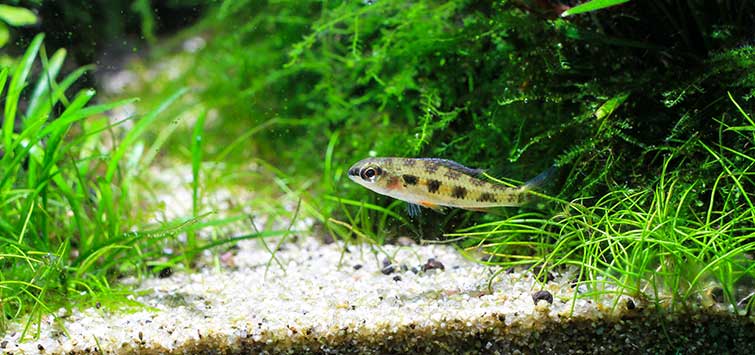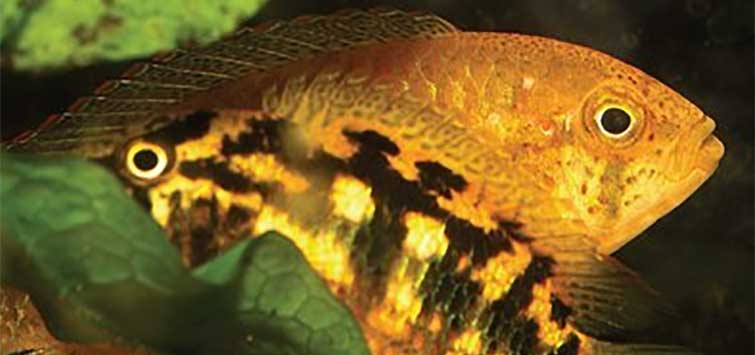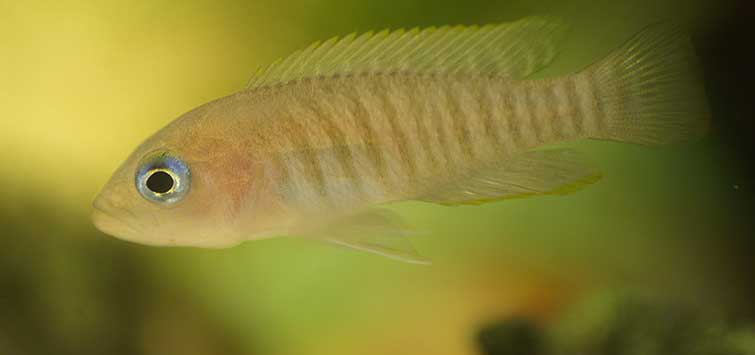The Checkerboard Dwarf Cichlid Dicrossus filamentosus
Author: Radek Bednarczuk
A big-personality cichlid in a little, colorful package, Dicrossus filamentosus has the looks and personality to charm aquarists that may not have the tankspace to house its larger cousins. A master fishkeeper outlines the aquarium care necessary to raise and breed the checkerboard dwarf cichlid.
Captivating Cichlids
Dwarf cichlids from South America have enjoyed undiminished popularity among hobbyists all over the world for many years. This is largely related to their small size, which does not require their keepers to possess huge aquaria. Other benefits to these fish are their attractive appearance, interesting repertoire of behaviors, and mode of reproduction. Species of the genus Dicrossus may not be as popular as Apistogramma species, but I can assure you that they are equally interesting and beautiful.
Dicrossus filamentosus (Ladiges 1958) was originally placed in the genus Crenicara, which consisted of all known cichlids featuring a checkerboard-like pattern on their bodies. In 1990 Kullander created the genus Dicrossus to separate the small, slender species from the bigger, deep-bodied ones, which he left in the genus Crenicara.
Appearance
A characteristic pattern on the body of these dwarf cichlids is two rows of square black spots, not unlike a checkerboard, that run along the center of the flank and below the dorsal fin. Depending on the mood of the fish, the lower row of spots can expand, forming a stripe that runs from the tip of the snout to the base of the caudal fin, while the row above it (below the dorsal fin) can disappear. The body of these attractive cichlids is slender, elongated, and copper-colored, the snout is blunt, and the mouth small.
Distribution in Nature
These dwarf cichlids inhabit the vast rivers of the Amazon, the entire upper western catchment of the Rio Orinoco, and the central and upper Rio Negro region of Brazil. Dicrossus filamentosus can be found in small forest streams, where the bottom is covered with leaf litter and a tangle of branches and roots. In this environment aquatic plants are a rarity, apart from the areas near the banks.
This dwarf cichlid lives in schools and larger groups, usually staying above the thick layer of fallen leaves, in which it will hide when faced with a threat. The pH in their natural environment falls in the range of 4.5 to 5, and the general hardness is below 1 dGH.
Conditions in the Aquarium
In order to maintain these fish, it is important to keep up to about a dozen specimens of the same species, preferably with companion fish such as Apistogramma spp. and dwarf Crenicichla spp., or small characins like the popular neon tetra. In the aquarium, decor plays an important role when it provides numerous hiding places in the form of coconut shells, petrified wood, driftwood, or pottery pipes, where the weaker or dominated individuals can find shelter.
The aquarium does not have to be high, but it is important that it should be relatively long—preferably no less than 120 cm (4 feet) in length. This species keeps to the bottom level of the tank.
Substrate
Dark sand can be used as substrate; a substrate that is too bright carries the risk of spooking the fish. It is advisable to include a few large pieces of dark wood, as this background will allow the fish to display the whole spectrum of their colors. The lighting should be rather muted and not too bright. Excellent filtration is also important, as well as good aeration and frequent water changes so that nitrates remain low—preferably undetectable with aquarium tests—not to mention the nitrites, which shouldn’t be there at all, as Dicrossus filamentosus is sensitive to poor water quality. The water current in the aquarium should not be too strong, however, to avoid causing discomfort to the fish—as I have already mentioned, they live in quiet, still waters.
Water Requirements
Do not forget the correct water parameters, either—that is, general hardness below 5 dGH and a pH of about 4 to 6.5. The temperature should fall in the range of 26° to 28°C (79° to 82°F). Neglecting water quality and a failure to provide the correct physical and chemical parameters will negatively impact the health of checkerboard dwarf cichlids. A good addition to the tank would be the leaves of the tree Terminalia catappa, which not only serve as an area for refuge but release valuable compounds into the water, which, among other things, slightly lower the pH and stimulate the fish to spawn, as well as having bactericidal and fungicidal properties. These leaves also simulate the natural environment in which this cichlid lives.
Plants
Plants can be added to make the tank less austere, but they must be of the kind that will tolerate well the parameters of the water in which they are to grow—for instance Microsorum, Amazon swords, or Java moss.
Feeding
As far as feeding is concerned, the food—because of their little mouths—should be of small size, such as frozen crustaceans like daphniaor brine shrimp (Artemia), as well as mosquito larvae. They can also be trained to take high-quality dry foods.
Reproduction
The males have a lyrate caudal fin with filaments at the top and bottom. They are also more colorful than the females and attain a length of about 9 cm (3 to 3½ inches), while the females grow up to 6 cm (2¼ inches). They lack the blue and red spots on their bodies and fins, and their caudal fin is rounded. When the pair is ready to spawn, the ventral fins of the female become a solid salmon red, while those of the male become red-and-blue striped.
Chemical Parameters
The largest obstacle to breeding these fish are the chemical parameters of the water. It is much easier to breed captive-reared specimens because those that come directly from the wild require a hardness of only a few microSiemens and a pH below 5.
But in most cases, water with a pH of 6 to 6.5, hardness of 1 to 3 dGH, and a temperature of 26° to 29°C (78° to 84°F) would be enough to guarantee breeding success. The water for the spawning tank is best obtained from an RO unit and prepared with mineral salts intended for dwarf cichlids of South America.
Courtship
For lucky owners of a mated pair, the spawning—as is typical with cichlids—will begin with spectacular courtship rituals. This species is best bred in harems—assuming, naturally, that the tank is big enough and the correct number of fish are on hand. The spawning is initiated by the female, who leads the male to a previously cleaned site. If everything goes well, the eggs, ivory or pale amber in color and a few dozen to a few hundred in number, are laid on a hard surface such as a stone. The female then undertakes the responsibility of caring for the eggs while the male defends the territory. Interestingly, after egg deposition the ventral fins of the female lose their red coloration, which is only regained after a few weeks when her offspring are fully independent. The male is best separated from the female, for it often happens that he eats his brood.
Larvae
At a temperature of 28° to 29°C (82° to 84°F) the larvae hatch in about two days, and then the female moves them to pre-dug pits in the substrate. After about five to eight days the young become free-swimming and can be fed with freshly hatched Artemia, microworms, and powdered dry foods. The female’s parental care can last for a few weeks.
Sometimes the egg plaque begins to fungus, and this can be treated to some extent by adding fungicides to the water, or delicately transferring all the eggs (together with the substrate—a rock, for instance) to a separate incubation tank, which can be a small, even 5-liter (1½-gallon) aquarium. It should be well-aerated and filled with water of the same physical and chemical parameters as that in the spawning tank. A fungicide should also be added here, and those eggs that have already fungused should be immediately removed. Also remember that water changes should be performed regularly, and debris removed from the bottom. The fry should then grow very quickly.
Fish for Experienced Aquarists
Dicrossus filamentosus are fish for experienced aquarists who have practiced in the hobby for some time. To sum up: A long tank, excellent filtration, proper physical and chemical parameters, frequent water changes, high-quality food, and, of course, a mated pair are the keys to breeding success. Reproduction of this species of dwarf cichlid will probably be a challenge for any aquarium hobbyist.
References
The Cichlid Room Companion: www.cichlidae.com
Konings, A. 2003. Enjoying Cichlids. Cichlid Press. Germany. 240 pp.
RÖmer, U. 2001. Cichlid Atlas, Vol. 1. Mergus Verlag. Melle, Germany. 1312 pp.
See the full article on TFH Digital http://www.tfhdigital.com/tfh/200912/#pg77

.png?h=595&iar=0&w=2781&hash=5FD5E69473BCC22199FBFA2FB71B6033)



